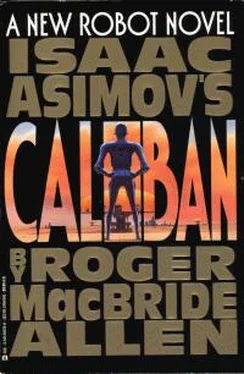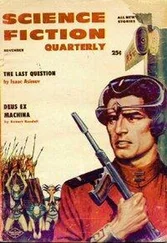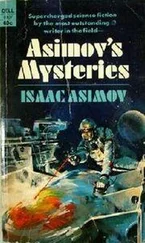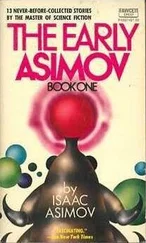Isaac Asimov - Caliban
Здесь есть возможность читать онлайн «Isaac Asimov - Caliban» весь текст электронной книги совершенно бесплатно (целиком полную версию без сокращений). В некоторых случаях можно слушать аудио, скачать через торрент в формате fb2 и присутствует краткое содержание. Год выпуска: 1997, ISBN: 1997, Издательство: Ace Books, Жанр: Фантастика и фэнтези, на английском языке. Описание произведения, (предисловие) а так же отзывы посетителей доступны на портале библиотеки ЛибКат.
- Название:Caliban
- Автор:
- Издательство:Ace Books
- Жанр:
- Год:1997
- ISBN:ISBN: 044-100482-2
- Рейтинг книги:4 / 5. Голосов: 1
-
Избранное:Добавить в избранное
- Отзывы:
-
Ваша оценка:
- 80
- 1
- 2
- 3
- 4
- 5
Caliban: краткое содержание, описание и аннотация
Предлагаем к чтению аннотацию, описание, краткое содержание или предисловие (зависит от того, что написал сам автор книги «Caliban»). Если вы не нашли необходимую информацию о книге — напишите в комментариях, мы постараемся отыскать её.
Caliban — читать онлайн бесплатно полную книгу (весь текст) целиком
Ниже представлен текст книги, разбитый по страницам. Система сохранения места последней прочитанной страницы, позволяет с удобством читать онлайн бесплатно книгу «Caliban», без необходимости каждый раз заново искать на чём Вы остановились. Поставьте закладку, и сможете в любой момент перейти на страницу, на которой закончили чтение.
Интервал:
Закладка:
The northern third of the world was given over to a single great landmass, the continent of Terra Grande. Even in summer, the polar regions of Terra Grande sported an impressive ice cap. In the winter months the ice and snow could reach halfway down to the sea…
Just north of Purgatory, a huge, semicircular chunk was neatly sliced out of the southern coast of Terra Grande, the visible scar of an asteroid impact some few million years ago. Hidden by the water, the arc of the landward edge of the crater extended out into the sea, forming a circular crater. Purgatory was actually the central promontory of the half-submerged crater. The huge water-filled crater was called, quite simply, the Great Bay.
Clouds and storm-whirls knotted and twisted about the southern seas, with the greens and browns and yellows of the sprawling northern continent half-hidden beneath their own cloud cover. Dots of lightning flickered in the midst of storms in the northwestern mountains, while the eastern edge of the Great Bay was cloudless in the morning light, dazzlingly bright, the coastal deserts gleaming in the sun, the greenswards of the forests and pastures beyond a darker, richer green.
A bit farther south and west along the coast of the bay, Alvar could just pick out the lights of Hades, a small, faint, glowing light in the predawn darkness.
“This is a real-time view of our world as it is today,” Grieg’s voice announced from the far side of the now solid-seeming globe. “We came to a waterless world with an unbreathable atmosphere. We gave it water and oxygen. Every drop of water in those oceans, we caused to be there. Every breath of oxygen in the air is there because we remade this world. We unlocked water from the rocks and soil and imported comets and ice meteors from the outer reaches of this star system. We put plant life in the sea and on the land and gave this world breathable air. We made this world bloom. But now the bloom is off the rose.
“Next you will see Inferno as it will be, if we merely rely on our own abilities, using just our own terraforming stations and technology, if we go on as we have been. First, to make it easy to observe, I will remove the atmosphere, cloud cover, and the day-night cycle.” Suddenly the half-lit globe was fully illuminated, and the storms and haze vanished. The hologram had seemed like a real world up to that moment, but, stripped of darkness and cloud, it was suddenly nothing more than a highly accurate map, a detailed globe. Quite irrationally Alvar felt a pang of loss even then. Something lovely that had been was suddenly gone, and he knew, beyond doubt, that the surviving image of the world would grow uglier still. “Now let me add a few supplementary graphics,” Grieg’s voice said. A series of bar charts and other displays appeared around the globe, showing the state of the forests, the sea and land biomass, temperatures, atmospheric gases, and other information.
“I will run the simulation forward at the rate of one standard year every ten seconds,” Grieg said, “and I will keep the western hemisphere positioned so you can watch the fate of Hades.” A white dot appeared at the appropriate position on the edge of the Great Bay. “That is Hades’s location.”
The governor spoke no more, but instead let the simglobe tell its own tale, partly in direct images, partly in readouts and graphic displays.
It was the oceans that died first. The predators at the top of the food chain overbred and all but wiped out the mid-chain species, the fish and other creatures that fed on each other and on the various species of plankton, and were in turn eaten by the high-end predators. Their food supply wiped out, the high-end predators died out as well.
With no controls on their reproduction, the plankton and algae in the ocean were next. They reproduced out of all control and the oceans bloomed a sickly, ghastly green. Then the seas turned brown as the algae died as well, having overrun their own food supply and absorbed virtually every molecule of carbon dioxide. With no animal life in the ocean, plant life everywhere, on land and sea, was starved for carbon dioxide. The loss of the greenhouse gas meant Inferno could retain less and less heat. The planet began to grow colder.
Alvar watched, an unwilling witness to the forthcoming doom of his own world, watched as the planet Inferno was strangled by ice. Water, water was the key. No living world could survive without it, but it could do no good—and could do great damage—if it was in the wrong state, in the wrong place. Now it was the ice cap that was the problem. The line on the chart displayed the size of the northern ice cap, but Alvar could see the cap itself growing. The ice advanced, and the northern forests fell before it, the great stands of trees dying in the too-cold, carbon-dioxide-starved air. With the atmosphere’s oxygen content far too high, and drought conditions taking hold, forest fires exploded everywhere, even as the ice pushed southward.
The white ice reflected back far more heat and light than the forests, and the planetary cooling trend locked itself in, strengthened itself, reinforced itself.
But the cooling was not universal: Alvar could see that. As the forest died and the ice advanced and the overall planetary temperature dropped, local temperatures dropped in some areas and rose in others. Wind patterns shifted. Storms grew more violent. Semipermanent snow hurricanes lodged themselves here and there along the southern coast of Terra Grande, while Purgatory became semitropical. But still the ice advanced, creeping farther and farther south, locking up more and more water in snow and ice, water that should have flowed back into the southern ocean.
The sea levels dropped. The oceans of Inferno, never very deep to begin with, receded at incredible speed as the ice grew ever deeper in the north. Islands began to appear out of the southern ocean. Still the waters drew back, until the Great Bay revealed its true form as a drowned crater. Now it was a circular sea, surrounded on all sides by land.
The ice mass continued to advance, and the city of Hades vanished under the snow and ice.
Suddenly the simulation froze. “You see this world as it will be, approximately seventy-five standard years from now. For all intents and purposes, by that time there will be no other life on this planet but ourselves. Some small remnant populations of this and that species might well survive in isolated pockets, but the world as a whole will be dead.” Alvar heard a grim graveyard chuckle in the darkness. “By the time the world is as we see it here, I suppose we humans ourselves could be regarded as a remnant in an isolated pocket.”
“I don’t understand,” Alvar protested, speaking to the faceless voice of the Governor somewhere in the dark. “I thought the danger was from the deserts growing, the planet getting too hot, the ice caps baking off.”
“That was what we all thought,” the Governor said bitterly. “Whatever desultory, token efforts my predecessor made to correct the situation were based on calculations and predictions to that effect. The deserts were supposed to grow, the ice cap to vanish completely, the sea levels to rise. There are plans in my files for dikes to be built around the city and hold back the rising water!”
Alvar heard the Governor step out from behind the console. He came around the side of the simglobe to stand by Alvar’s chair and look at the half-frozen world. “Perhaps I am being unfair. The situation is remarkably complex. If one or two variables shifted slightly, it would be the sea, and not the ice, that would overwhelm the city. In fact, stage one of our revised terraforming plan is to tip the scales back toward the collapse—into-desert, coastal-flooding scenario—it is a less drastic catastrophe than the ice age we otherwise face. You have not seen the worst of the ice age yet.”
Читать дальшеИнтервал:
Закладка:
Похожие книги на «Caliban»
Представляем Вашему вниманию похожие книги на «Caliban» списком для выбора. Мы отобрали схожую по названию и смыслу литературу в надежде предоставить читателям больше вариантов отыскать новые, интересные, ещё непрочитанные произведения.
Обсуждение, отзывы о книге «Caliban» и просто собственные мнения читателей. Оставьте ваши комментарии, напишите, что Вы думаете о произведении, его смысле или главных героях. Укажите что конкретно понравилось, а что нет, и почему Вы так считаете.







